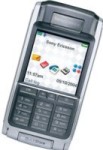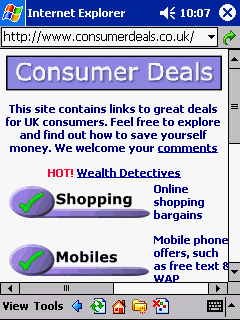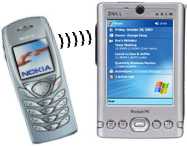Help and advice on what to look for when buying a PDA that’s able to go online
There are many sites
dedicated to helping people identify the best handheld device for their
needs. This page offers advice from the perspective of a user’s requirement
to be connected while on the move, for email and Internet access. If there’s
something you’d like to see added, please let
us know.
For some general advice on buying a PDA, see our PDA
buyers page
If you’re looking for a handheld way to connect to the Internet for email
or web surfing, there are two options open to you – using a dedicated
all-in-one "smartphone", or using a handheld computer coupled
with a mobile phone.
One-box solutions
A one-box solution
is a smart way of getting online. Rather than having a handheld computer
connecting to a mobile phone via infrared or Bluetooth,
the one-box solution gives you everything you need in one package – in
other words, a handheld computer with a built-in phone, or a phone with
built-in email/web software. Particularly popular in this area are the
following:
- Windows Mobile devices – such as the Qtek S200 or the o2 XDA -These Pocket PC devices are combined PDA and mobile phones with all the software you need, and excellent connectivity options
- Symbian OS devices – such as the Nokia 6680 or the SonyEricsson P910i. Symbian’s software started life on the Psion range of PDAs, and has evolved to be a powerful smartphone platform with built-in web browser and
email software
The real advantage
of the one-box solution is the simplicity – there’s a lot less fiddly
setup needed, and the solution just works.
 o2 XDA Orbit Features: GPS Sat Nav, Web & Email Connect: wi-fi, USB, Bluetooth Free on contract From: O2 online |
 SonyEricsson P910i Features: Web & Email Free on contract From: MobileShop |
 Nokia 6680 Features: Web & Email Free on contract From: Carphone Warehouse |
 Palm Treo 680 Features: Web & Email Available without contract From: Palm Store |
Two-box solutions
Two box solutions
(a separate phone and computer) tend to be cheaper options, and if you’re
really budget-conscious and not looking for the most up-to-date stuff,
end-of-line models, or even second-hand machines can be the way to go.
The down-side is that in order to connect the handheld computer to the
phone, you need to connect either with a cable, or more commonly, wirelessly
using either infrared or Bluetooth – all of which can be a little fiddly
to set up.
 PC |
 Palm OS |
 Psion handhelds |
Looking for a PDA? We recommend totalpda.co.uk
Ways to connect
If you’re using a
one-box smartphone, you’ll probably have all you need already. For a two-box
solution, you’ll need to have the following:
- A handheld computer
that has Internet / email software - A mobile phone
with a built-in data modem - A way of connecting
the two – most commonly you’ll need both boxes to have Infrared. You
can also connect via Bluetooth, or in some cases via a dedicated cable
connection. Infrared is the most common, requires the two boxes to be
in line-of-sight with each other, and is the least complicated to set
up.
You’ll also need an Internet service
provider (your existing provider should be fine), and a mobile phone account
with a network operator (such as Vodafone,
o2, Orange, T-Mobile,
etc). Note that your mobile phone service must be "data-enabled".
A phone call to your network operator will get this done, and there’s
normally no charge for setup.
 Email on a SonyEricsson P800 |
 Browsing on a Nokia 3650 |
 Surfing on a Pocket PC |
| Tip. Bookmark this site if you’re planning to connect your handset to the Internet. We have pages of configuration on getting online with a Pocket PC, Palm or Psion machine, plus help with setup for Symbian smartphones, and online settings for BT Yahoo and o2. |
Running costs
The most common way
of making a connection to the Internet when on the move, is via a dial-up
service… In other words your smartphone or pda/mobile dial a phone number
supplied by your Internet Service Provider (BT Yahoo, Virgin Media, Tiscali, etc).
You can expect to be billed for every second that you’re online. Some
things to note:
- In the mobile phone
world, don’t expect a low-call 0845 or a local-rate dial-up number to
be cheaper… Commonly you’ll be paying the standard rate for a call
to a landline number (check your network operator’s tariff) - Your mobile operator
may offer you free minutes, but internet numbers may not qualify – so
check your contract/tariff to confirm this. If you don’t get free minutes,
consider shopping about for a new tariff. - Connection over
a dialup service from a mobile phone is slow. You’re looking at data
speeds of 9.6kbps – a PC modem is 56kbps - Consider using
GPRS instead of a dial-up service. GPRS is faster than standard dialup,
but is billed differently (per megabyte, not per second). It’s also
not available on all handsets, has to be enabled by your network operator,
and can be a little quirky to set up.
Case Study 1: Two-box solution
 PDA:
PDA:
Dell Axim Pocket PC
Phone: Basic Nokia mobile phone with Bluetooth or IR
The Dell Axim range of Pocket PCs have had excellent reviews, contain a fair amount of power for their size and cost, and tend to be reasonably-priced. These PDAs come
with all the software that you need to connect to the Internet. For the
handset, we’re using the now obsolete Nokia 6100, which is a medium-range handset with
a built-in modem and infrared connectivity for use with the Pocket PC.
We’re using a free Internet service from BT Yahoo.
Cost: Dell
Axim Pocket PCs start from around £200 (directly from www.dell.co.uk).
You can pick up a basic Bluetooth-enabled phone free on contract at O2 online or from Carphone
Warehouse – expect to pay around £20 a month
| Costs Hardware cost: £200 Monthly rental: £20 (for the mobile phone) Online costs: 10p per minute Internet charge: nil Extras: Up to 1000 free texts and an inclusive GPRS WAP allowance |
Links
- For some general advice on buying a PDA, see our PDA buyers page
- For more on PDAs,
see our PDA page - For more on smartphones,
see our smartphone page

